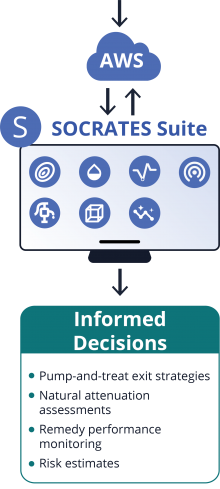Highlights
Overview

Convenient access to environmental data and consistent, reproducible, and rapid analytics to support environmental decision-making
- Analytics to support remedy exit strategies, remedy optimization, and adaptive site management
- Rapid analytics based on standard statistical methods and U.S. Environmental Protection Agency and U.S. Geological Survey guidance
- Integrated profile management system that supports workspace customization and streamlined web-based reporting and analysis
- User dashboard that facilitates saving and sharing of data analyses, graphics, and working sessions and facilitating technical communication
- Implementation on Amazon Web Services for robust and reliable performance
- Cloud computing for performing computationally intensive near-real-time analytics for big data (e.g., satellite and remotely sensed data)
- Developed under a program that is compliant with the American Society of Mechanical Engineers Nuclear Quality Assurance (NQA-1) standard
Access
Access to individual modules within SOCRATES is granted through a managed system. Some modules are only available to site contractors and the U.S. Department of Energy, whereas other modules, like CRATES, are also accessible to the public.
Data Sources
SOCRATES links with authoritative sources of environmental site databases, with regular data synchronization to keep data current. This data may include groundwater contaminant concentration and water level data, pump-and-treat (P&T) system sensor data and in-plant chemistry, 3D geologic framework data, and satellite images, depending on the modules that are active.
Resources
The Center for the Remediation of Complex Sites, or RemPlex, offers seminars. Watch the presentation from March 31, 2021 or download the slides, and check the seminar page often for more upcoming events.
The SOCRATES Name
SOCRATES stands for a Suite Of Comprehensive Rapid Analysis Tools for Environmental Sites. It’s also a clever reflection of its namesake.
Ancient Greek philosophers observed and interpreted the world around them, forming the early basis for Western science and natural philosophy. Tools within SOCRATES are named for Greek philosophers because they can be used to readily analyze and interpret subsurface conditions and support site management.
- GALEN. Galen was a physician who discovered that arteries carry blood. He compiled all Greek and Roman medical literature available at that time. GALEN analytics focus on flow of groundwater rather than blood, using a compilation of groundwater well data.
- PLATO. Plato, the preeminent Greek philosopher of his time, emphasized one’s abilities to think and reason rather than depending on the senses to perceive knowledge. Similarly, the PLATO toolset provides contaminant concentration analytics that offer objective metrics for decision-making.
- ARIUS. Arius was a teacher of philosophy and advisor to the emperor Augustus who summarized Peripatetic and Platonist philosophies. The term Peripatetic means "of walking" or "given to walking about.” The ARIUS interface uses remotely-sensed data to identify changes in surface elevation, as a surrogate for land surveys requiring labor-intensive walkabouts.
- ORIGEN. Origen was known for the originality and power of his mind as well as for his vast learning and prolific writings. His most well-known work is titled On First Principles. The visualization of site geology in ORIGEN is also a first principle associated with understanding the site conceptual model and subsurface flow and transport.
- CRATES. Crates was one of the most important Cynic philosophers of ancient Greece, a philosophy that emphasized the rejection of material wealth, objects, and social status in favor of a life lived simply and in accordance with nature. The CRATES module visualizes measured groundwater concentration and water level data with a simple, intuitive interface.
- HYPATIA. Hypatia dedicated her life to the service of knowledge and learning, with mathematics being an important key to the life of higher contemplation. The HYPATIA module not only shares rapid visualization of P&T data, but applies mathematical analyses that can help understand system performance and optimize facility operations.
- ARISTOTLE. Aristotle is known as one of the greatest philosophers, and as the first scientist, he invented the field of formal logic, and various scientific disciplines, exploring their relationships to one another. The ARISTOTLE toolset provides a way to organize vast amounts of waste inventories, exploring their relationships to one another and in relation to existing groundwater plume data.